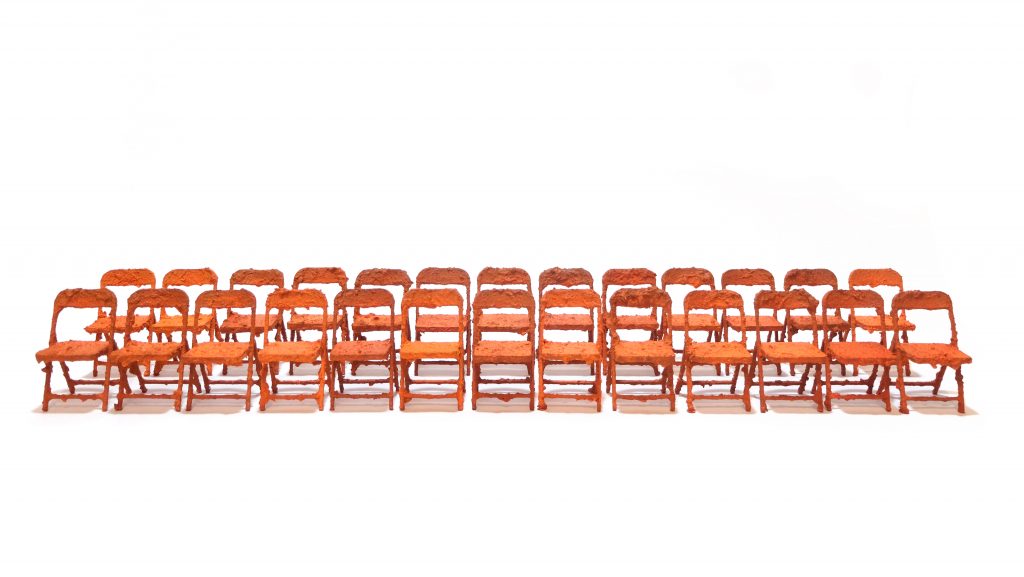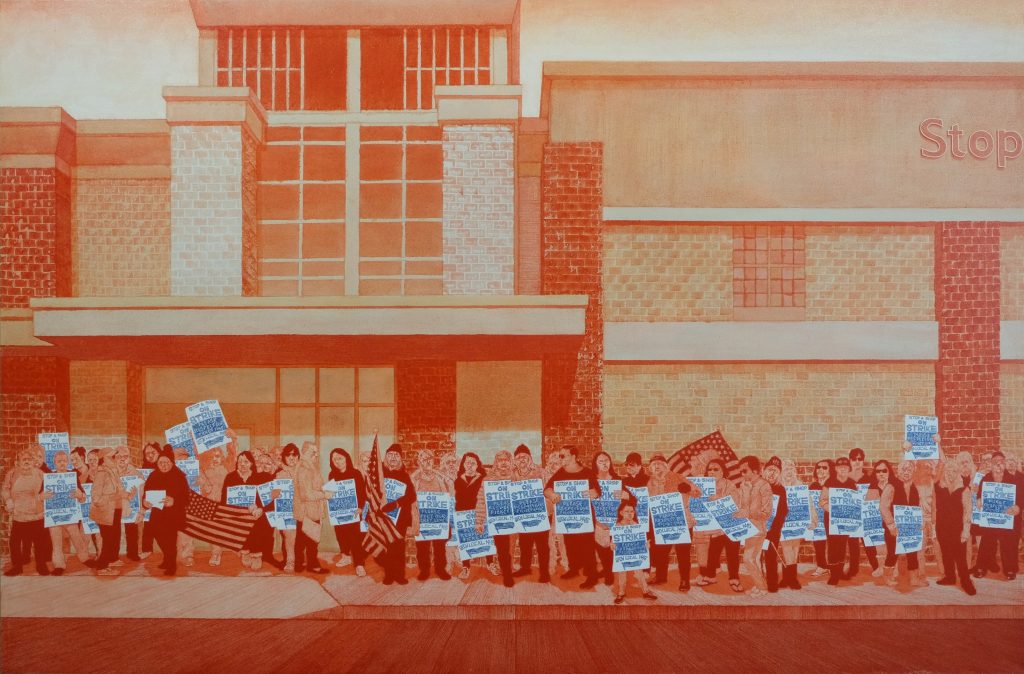
The Unions have been a part of Zach Horn’s life since childhood – his father was the president of the Cheltenham Educators’ Association, and his grandmother Bernice helped organize the Philadelphia public school teachers back in the early ’60s, joining a picket line and even spending a night in jail. “She taught me to see labor rights as a matter of fairness,” Horn told us; his current exhibit at the Museum of Work and Culture in Woonsocket, United We Bargain, Divided We Beg, is inspired by those ideals.
The impetus for the exhibition came when Horn’s neighbor Jimmy was locked out of work for 7 weeks during the Verizon Strikes in 2016. What began as a show of solidarity with the workers of the local IBEW 2222 evolved into an ongoing body of work spanning 4 and a half years and involving Horn with multiple labor unions in Massachusetts and New Jersey.
Horn takes a unique approach to his portrayal of workers. He earned his MFA in painting at Boston University (where he currently is a lecturer and teacher) and while there, he spent a lot of time in the Museum of Fine Arts. He realized that something bothered him about the contrast between the presentation of the upper elite society and the portrayals of peasants – the royal subjects were fully realized as individuals, while field workers were anonymous and faceless. In United We Bargain, Divided We Beg, Horn decided to correct this historical injustice and humanize labor workers by basing the style of his paintings on classical portraits of aristocrats by such artists as Rubens and Franz Hals. Workers looked straight at the viewer, and the tools of their trade were given the dignity afforded scepters … or weapons.

Where Horn departs from the masters is in his choice of mediums – his portrayal of IBEW members around a union negotiating table may base its design on The Last Supper, but it is painted on Tyvek insulation sheeting, using Asphaltum, a workable tarry substance that smells like asphalt. Horn uses a very minimal color palette and employs materials indigenous to construction and industrial sites. His stony portraits of the Hudson County Central Labor Council were achieved by mixing marble dust into the paint; he collected sawdust from the basement of a union training center to lend authenticity to his portrayals of wood workers.
Horn told us that he first began to understand how assaulted the unions feel on a hot summer day in Boston when he showed up to a meeting of the Iron Workers dressed in gym shorts and sneakers. The workers were wearing heavy steel tipped boots and utility clothes covered in rust and grease. Horn was clearly out of place. “They looked at me like I was a Narc and refused to let me inside,” Horns recalls. But that was when it struck him: “The unions are constantly under attack; they have to protect themselves against the outside world.” In many of Horn’s later pieces, the workers have their backs to the viewer to show the distance between the inside and out.
Horn considers himself first and foremost a painter, but as his collection of work grew and reached new venues, he found himself faced with display cases that demanded sculptures. For the first, he made a collection of figures representing the Marine Engineers’ Union, lounging in chairs with their backs turned to the viewer. He painted them in dull sea tones: “I wanted to make them look like they were dragged out of the ocean.” He used a laser cutter to form plexiglass chairs, and Sculptamold, a mixture of plaster and paper pulp, to create the human figures.
Horn’s collaboration with the Boston Teachers’ Union takes on a feminist twist, inspired by Delacroix’s Liberty Leading The People – but in his depiction, Horn shifts the viewer’s position and takes us inside the ranks, showing the backs of the women as they are marching; we are swept up, becoming a part of the forward movement. Every union group Horn works with is seen from a fresh perspective – the Stop & Shop workers on strike in 2019 are painted entirely in shades of red, reflecting the fear and uncertainty faced by every individual on the line.
Horn likes the idea that his work is somehow cyclical – “going to meetings, photographing the people, exhibiting the work and then somehow returning it to them … it feels like the natural conclusion to this mission.” His panels of the local IBEW 2222 were first exhibited at the Commonwealth Museum, then the American Labor Museum, “then the IBEW Local 827 picked them up directly from there. Took them to their hall in NJ in the back of a pickup truck.”
Horn’s exhibit at the Museum of Work and Culture is a time capsule: “This contemporary work is the latest episode in that history of labor. It also makes us remember how fragile our gains are – if we take child labor laws, 40 hour work weeks, health care and retirement for granted, then we do so at our own risk. If we want to have a middle class in this country, we need to make sure that our labor laws are strong and unions have public support. This is my real goal, to work with the unions to show my support, to bring the art to the union halls and to preach the message.”
United We Bargain, Divided We Beg is at the Museum of Work and Culture through Dec 30, 42 S Main St, Woonsocket. In-person visits by appointment only, call for museum hours 401-769-9675. To take the virtual tour, visit: zachhornart.com/gallerytalk
